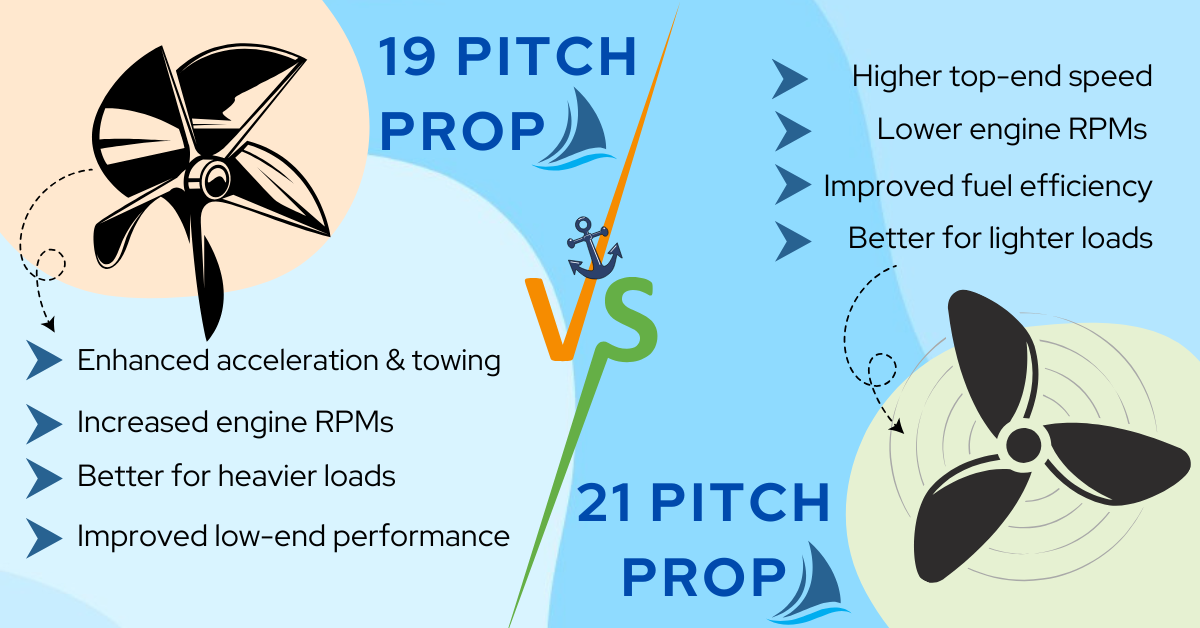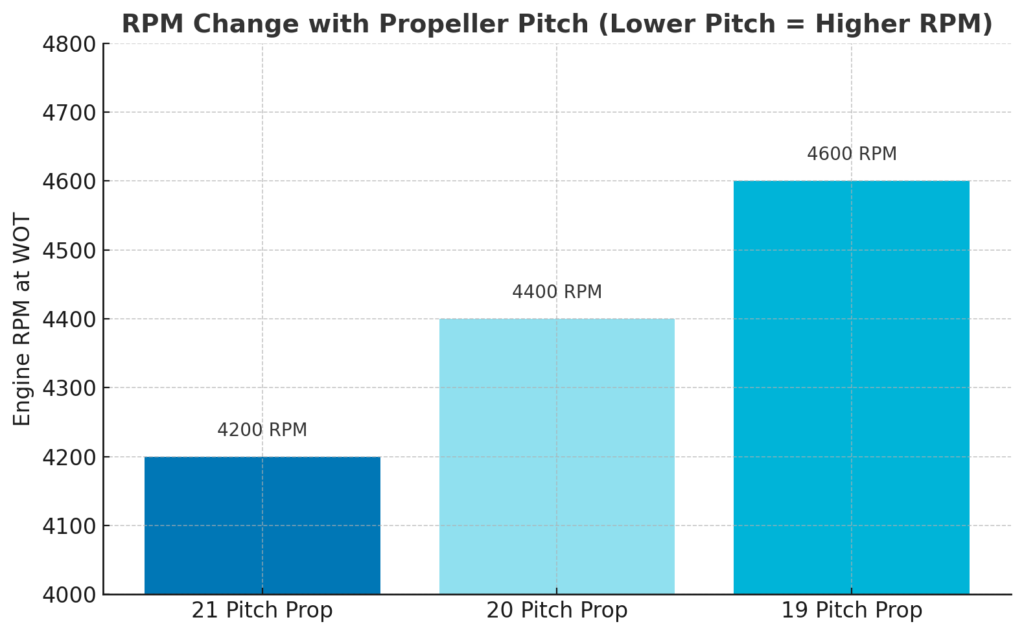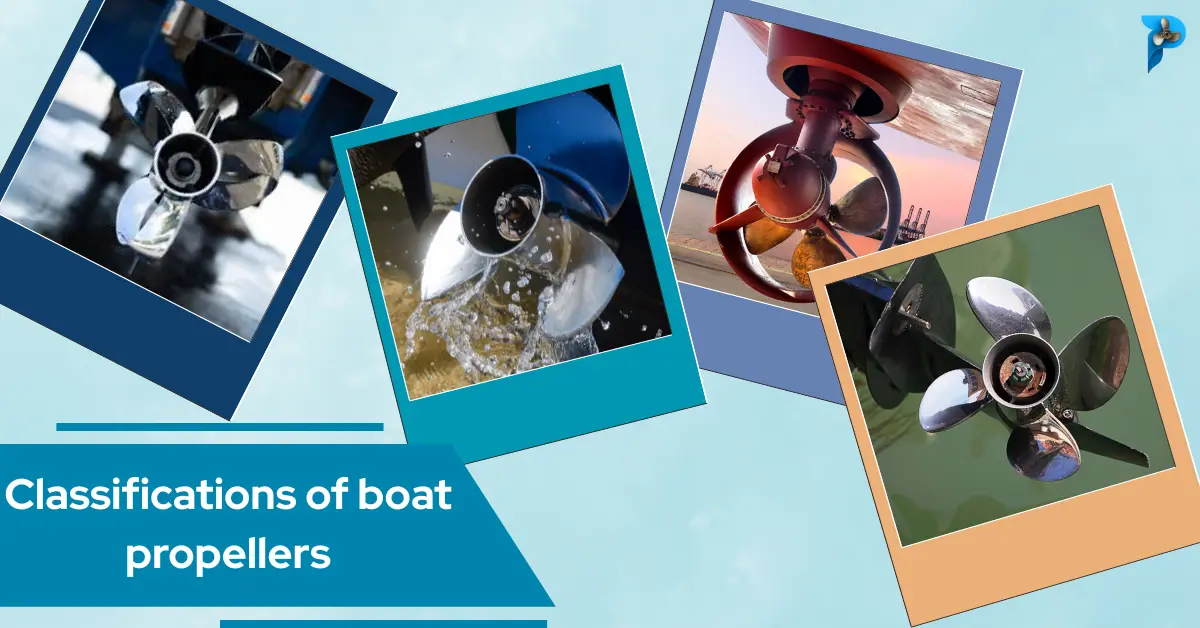Ever pushed your boat to the throttle, only to feel it drag instead of glide? The issue might not be the engine; it’s likely the propeller pitch. Many boaters face confusion when deciding between a 21 pitch prop vs. 19 pitch prop.
However, propeller pitch directly affects your boat’s speed, fuel efficiency, and handling. Choosing the right one is important because it can transform your boating experience. Well, in this guide, we’ll explore the differences, share performance insights, and help you find the perfect fit for your needs.
What Is the Propeller Pitch?
Propeller pitch is the distance a propeller moves forward in one rotation. You can visualize it like a screw moving through wood. A propeller “screws” through air or water the same way.
Pitch affects speed and engine performance. A lower pitch means the propeller spins faster (higher RPM) and gives quicker acceleration. Well, it’s not great for top speed. A higher pitch moves the propeller farther in one spin. This lowers RPM and improves top speed, but it takes more power.
So, the pitch affects speed and RPM like this:
- Lower pitch = Higher RPM and quicker acceleration
- Higher pitch = Lower RPM and higher top speed
However, the pitch also impacts fuel use. A lower pitch uses more engine power and burns more fuel. Whereas a higher pitch is more fuel-efficient at steady speeds but needs a stronger engine.
You have to choose the right pitch after deciding how you want to balance speed, power, and fuel efficiency. It’s more like choosing the right gear on a bike for the job you need.
21 pitch prop vs. 19 pitch prop: Quick Comparison
Picking the best prop pitch for boating performance can feel tricky, especially when it’s between a 19 pitch prop and a 21 pitch prop. Each has a unique effect on how your boat performs.
To make your decision easier, here’s a simple comparison to help you choose what works best for your boating adventures.
| Feature | 19 Pitch Prop | 21 Pitch Prop |
| Best Use | Quickstarts, strong pull | Long trips, higher top speeds |
| Performance | Higher RPM, faster acceleration | Lower RPM, stable cruising |
| Fuel Efficiency | More fuel at high RPM | Better for steady cruising |
| Engine Impact | This may cause lugging at low RPMs | This may cause lugging at low RPM |
| Speed | Better at low speeds | Better at top speeds |
| Material | Aluminum (light, cheap) | Stainless steel (durable) |
Major Differences Between 19 Pitch & 21 Pitch Props

The main difference between 19 pitch and 21 pitch props is that a 21 pitch prop provides more speed but less acceleration, while a 19 pitch prop offers better acceleration but lower top speed.
When you decide between 19-pitch and 21-pitch props, it is important to grasp how they affect your boat’s performance. Also, you should check out the fuel efficiency and the boat’s engine. Let’s break it down:
Boat Type and Usage
The 19-pitch prop is better for boats that need quick starts and strong acceleration, like fishing boats or boats pulling skiers. It provides a better “hole shot.” It means the boat gets up to speed faster.
The 21-pitch prop works well for boats used for long-distance cruising or reaching higher top speeds. It is better for those who prioritize speed over quick starts. You must choose the prop based on your boat type and how you want to use it.
Performance at Various RPM
The prop diameter and RPM relationship is more serious than you can expect. The effect of propeller pitch on RPM matters. A 19-pitch prop lets higher RPM at the same throttle. For example, a 19-pitch at 3000 RPM prop offers 34 mph, while a 21-pitch prop would provide 30 mph.
If you pick a 19-pitch over a 21-pitch prop, it can elevate the engine’s RPM by about 400 revolutions per minute. Here, each inch of pitch typically increases RPM by 200 RPM.
In the case of an under-revving engine, a lower-pitch prop can help achieve optimal performance. However, if you are seeking fast acceleration, the 19-pitch prop is the better choice. On the other hand, the 21-pitch prop is great for steady cruising at higher speeds.
To help visualize this, here’s how RPM changes when switching from a 21 to a 19 pitch propeller:

As shown above, a 19-pitch prop increases RPM at wide-open throttle compared to a 21-pitch prop. This can help engines struggling to reach their optimal RPM range.
Fuel Efficiency
Fuel usage depends on how you drive and the prop you use. A 19-pitch prop burns more fuel at higher RPM because the engine works harder. It is fine for short trips or pulling activities.
The 21-pitch prop is better for fuel efficiency during steady cruising. It lowers engine strain and uses less gas over time. If you often travel long distances, the 21-pitch prop will save you more fuel.
Wear and Tear on the Engine
As I mentioned multiple times, a wrong prop can damage your engine. A 21-pitch prop may cause lugging if your engine struggles to gain a Wide Open Throttle (WOT) range of 4200 to 4600 RPM. So, lugging can create overheating and engine wear over time.
While a 19-pitch prop keeps RPM higher, it reduces lugging risks. But if over-revved, it can strain the engine too. You should always check your engine’s performance and stick within the recommended RPM range.
Diameter and Blade Count
The diameter and blade count also affect performance. A 19-pitch prop often has a larger diameter, which increases torque. It helps with strong acceleration but can reduce top speed.
On the contrary, a 21-pitch prop usually has smaller-diameter blades. It improves speed but reduces low-speed power. More blades can also improve stability and reduce slippage. So, you must pick the right size and blade count for your boat’s engine and activities.
Cupping and Rake
Cupping and rake improve prop performance. Cupping refers to the curve on the propeller blade’s edge. A 19-pitch prop may have less cup sharpness. Also, it is better for quick acceleration.
A 21-pitch prop often has more cupping and a higher rake angle. This condition improves top speed and efficiency. For example, props like the Hustler focus on speed, while Vortex props balance speed and power.
Material Choices
Props generally come in two types of materials, and there’s often confusion when comparing aluminum and stainless steel. Aluminum props are more affordable and suitable for casual applications. They are light in weight but significantly less durable. On the other hand, stainless steel props are more robust and have better resistance to wear.
If you’re seeking reliable performance with reduced slippage, stainless steel is the preferred choice. It performs better for high-speed boating and challenging waters. For example, the SOLAS RUBEX Prop 14.3″ x 17″ provides outstanding stern lift, smooth mid-range acceleration, and improved stability, thanks to its high-rake, cupped blade design.
For lighter usage or budget constraints, aluminum props can still deliver decent results. The Quicksilver Nemesis Aluminum Propeller offers quicker acceleration and enhanced grip during turns. It’s perfect for watersports or leisurely boating.
Lastly, keep in mind that a 19-pitch prop is excellent for rapid starts and acceleration, while a 21-pitch prop shines in fuel efficiency and maximum speed.
Real-World Scenarios and Case Studies
Understanding propeller performance isn’t just about theory; it’s about how changes impact real boats on the water. Real-world scenarios help you see the practical implications of choosing a 19-pitch or 21-pitch prop.
Whether it’s unexpected RPM shifts or surprising fuel efficiency results, these case studies highlight why testing and adjustments matter. Let’s learn about the two boaters’ experiences and their takeaways.
Case Study 1: Benny’s SeaRay with 19- and 21-Pitch Props
Benny’s Boat Setup
- Model: 1986 SeaRay
- Engine: 5.7L V8 Mercruiser Alpha 1
- Original Prop: 21-pitch, 5-blade stainless steel (SS) HighFive
What Happened
After losing the 21-pitch prop, Benny replaced it with a 19-pitch stainless steel spare. He expected an RPM increase, as lower-pitch props typically allow for higher RPMs. But surprisingly, the RPM at wide-open throttle (WOT) dropped to below 4000, lower than the engine’s recommended 4200 to 4600 RPM.
Performance Insights
- Speed Comparison: At 3000 RPM, the 19-pitch prop hit 34 MPH, compared to 30 MPH with the 21-pitch prop.
- Fuel Efficiency: Benny reported stable mileage due to his habit of driving conservatively.
- Challenges Faced: The larger diameter and cup design of the 19-pitch prop likely required more torque, affecting RPM. High-speed tilting to the port side indicated possible trim issues.
Key Takeaway
Testing different prop designs and closely monitoring RPM is crucial for finding the ideal balance between performance and engine safety.
Case Study 2: Sunbird Corsair with Volvo SX Engine
Sunbird Boat Setup
- Model: 20-foot Sunbird Corsair
- Engine: 5.0 Volvo SX
- Prop Change: From 14.25 x 19 aluminum to 14.25 x 21 Michigan Wheel Vortex
What Happened
The boater expected a speed increase and RPM drop with the 21-pitch prop. However, the opposite occurred; RPM jumped from 5300 to 5500, while speed dropped from 44 MPH to 41.5 MPH.
Performance Insights
- Design Factors: The 19-pitch Turning Point Hustler prop had better rake and cupping, improving performance. The 21-pitch Vortex prop’s smaller blade area led to more slippage.
- Material Differences: Aluminum props performed differently from stainless steel options due to structural variations.
Key Takeaway
Prop performance depends not just on the pitch but also on design elements like cupping, rake, and blade area. Experimenting with multiple options and maintaining a clean hull is essential for optimal results.
Both case studies underscore the importance of practical testing, fine-tuning, and prop selection based on boating goals.
When to Choose a 19-Pitch Prop
A 19-pitch prop is perfect for specific boating needs. Its lower pitch offers unique advantages, especially for tasks requiring power and quick response. Here’s when a 19-pitch prop becomes the right choice:
Quicker Acceleration and Hole Shots
A 19-pitch prop is perfect for activities that demand fast acceleration, like water skiing or pulling tubes. It helps your boat get on the plane quicker. Also, it is excellent for towing and sports.
The SOLAS RUBEX 14.5″ × 19″ Aluminum Propeller is designed for boat enthusiasts looking for better acceleration and maximum speed. Made with SOLAS’s unique squeeze-cast aluminum technique, it guarantees both strength and performance.
Its broad blade design is especially ideal for 4-stroke engines, providing enhanced grip and minimizing slippage. This propeller is a great option for individuals who value quick hole shots and agile handling.
Temporary Replacement for a 21-Pitch Prop
If your 21-pitch prop is unavailable, a 19-pitch prop can work as a substitute. However, it may slightly affect speed and fuel efficiency. I would recommend that you look further instead of just going with the wrong prop.
RPM Monitoring to Avoid Underperformance
A 19-pitch prop often increases RPMs. It makes sure your engine stays within its recommended wide-open throttle (WOT) range. Also, it prevents underperformance or engine damage.
Boats Requiring Higher Torque
For heavier boats or those operating in rough conditions, a 19-pitch prop offers better torque. Also, it can improve maneuverability and handling in challenging situations.
Choosing a 19-pitch prop can elevate power and acceleration but requires careful monitoring to maintain optimal engine performance.
When to Choose a 21-Pitch Prop
A 21-pitch prop is ideal for boaters who prioritize speed and fuel efficiency during extended cruising sessions. It offers a balance of performance and economy. So, it is suitable for specific boating scenarios. Here’s when to go for a 21-pitch prop:
Higher Top-End Speed at Lower RPMs
A 21-pitch prop is designed for higher speeds. It reduces engine strain by achieving greater distances per rotation. As a result, it can deliver smooth and fast rides with fewer RPMs.
The Quicksilver Nemesis 14″ × 21″ Aluminum Propeller is engineered to provide exceptional acceleration and performance in the mid-range. Its high-rake and smaller diameter design contribute to sustaining top speeds, making it perfect for tow sports and family outings on the water. With an acceleration that is 16–25% quicker than standard 3-blade aluminum props, it delivers improved grip and control, ensuring a seamless and agile boating experience.
Optimized Cruising & Fuel Efficiency
If you are looking for good fuel mileage during steady cruising, the 21-pitch prop is the right choice for you. It minimizes engine effort at mid-range speeds. Thus, it can improve long-term fuel efficiency.
Match Prop Choice to Engine Specifications (WOT Range)
Always try to ensure the 21-pitch prop keeps your engine within its recommended wide-open throttle (WOT) range. Over-propping can cause lugging or overheating. So proper testing is essential to avoid damage.
Identify Potential Slippage with Proper Tuning
While 21-pitch props excel at speed, they may face slippage because of blade design or improper setup. Correct tuning, along with selecting the right rake and cupping features, can elevate grip and overall performance.
So, you should choose a 21-pitch prop for efficient cruising and top-end speed. At the same time, you must consider engine compatibility and setup for the best results.
If you want to check our other blog on the 17 pitch vs 15 pitch prop.
How to Test and Choose the Right Propeller
If you want to choose the right propeller, it will confirm that your boat performs efficiently. Also, it can protect your engine. Here’s a step-by-step guide to testing and selecting the right propeller:
Understand Your Boating Needs
You should define your priorities; they could be quicker acceleration, higher top-end speed, or fuel efficiency. Your propeller choice should match your boat’s primary purpose, like water sports, cruising, or fishing.
Check Engine Specifications
Review your engine’s recommended wide-open throttle (WOT) range. A tachometer like the Sierra International Tach Amega 3″ is perfect for monitoring RPMs accurately, ensuring your engine stays within its optimal range.
Start with the Current Propeller
Test your boat with the propeller you already have. Record RPM, speed, and fuel efficiency at different throttle levels. Using a Humminbird PiranhaMAX 4 GPS Fish Finder can help track your boat’s speed and route for precise baseline measurements.
Test Different Propellers
Experiment with props of varying pitches and materials. Lower-pitch props increase RPM for quicker acceleration, while higher-pitch props reduce RPM for better speed and fuel efficiency.
For detailed tracking during tests, a Garmin Striker 4 with Transducer provides both GPS speed tracking and sonar data to evaluate performance comprehensively.
Consider Additional Factors
Blade count, diameter, rake, and cupping affect the overall performance. For example, more blades can increase torque, while a larger diameter can influence handling.
Monitor Performance
You should pay attention to how the prop impacts your engine’s RPM, fuel efficiency, and performance. You can test with a GPS for speed and a tachometer for RPMs. This process will provide you with accurate results.
Look for Professional Advice
A marine mechanic or propeller expert can help fine-tune your choice. He can properly observe your boat’s setup and use case. After judging everything, he can give you the best possible suggestions.
End Note
Undoubtedly, choosing between a 19-pitch and 21-pitch prop depends on your goals. If you need quick acceleration, the 19-pitch is your best bet. For smoother cruising and higher speeds, go for the 21-pitch prop.
Remember to monitor your boat’s performance and adjust if needed to avoid engine strain. Finding the right prop can make every ride better.
Do you have propeller stories or insights? Share them in the comments. Your experience might just help another boater!
FAQs
Which prop is better for fuel efficiency: 19 or 21 pitch?
A 21-pitch prop is better for fuel efficiency during steady cruising. As it reduces engine strain and burns less fuel compared to a 19-pitch prop.
Can a 19-pitch prop harm my engine?
A 19-pitch prop can harm your engine if over-revved or used with an engine that cannot reach the required RPM. Also, it can cause strain and potential engine damage.
Can I use a 19-pitch prop on any boat?
No, a 19-pitch prop is not suitable for all boats. It works best on boats needing quick acceleration. Yet, it may not optimize performance on boats designed for top speed.
Will switching to a 21-pitch prop damage my engine?
Switching to a 21-pitch prop won’t damage your engine if it operates within the recommended RPM range. However, if the engine struggles to achieve WOT, it can cause lugging and damage.
What are the signs of an incorrect prop setup?
Signs of an incorrect prop setup are poor acceleration, underperformance, high RPMs without sufficient speed, engine lugging, and excessive fuel consumption. These signs indicate the prop doesn’t match the boat’s needs or engine specifications.






